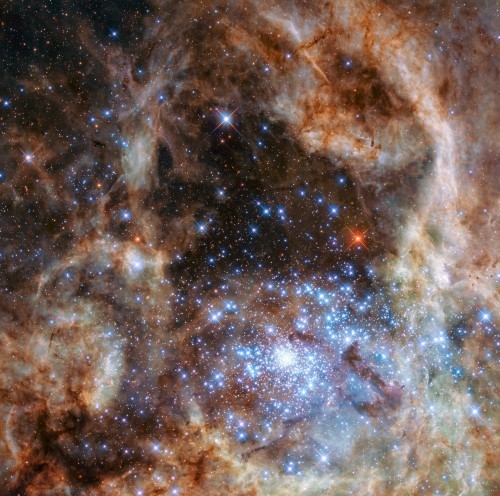Hubble has studied a cluster with 9 giant stars 100-250 times more massive than the Sun

R136 star cluster in the Tarantula Nebula from the Large Magellanic Cloud
An international team of scientists combined photos taken with Wide-angle camera 3 (WFC3) and data from a high-resolution spectrograph in the ultraviolet range of Space Telescope Imaging Spectrograph (STIS) - and first studied the young star cluster R136 in the ultraviolet .
The results, which were published yesterday in the Monthly Notices of the Royal Astronomical Society , raise many questions about the formation of massive stars.
The cluster R136 was previously known as the location of the supermassive star R136a1 in more than 250 solar masses. In 2010, it was revealed that there are four stars in the cluster with more than 150 solar masses. A careful study of this cluster has now shown that there are at least nine giants. Each of the stars is more than 100 times more massive than the Sun. This is the largest cluster of massive stars found so far.
')
R136 is about 170,000 light-years from Earth. The luminosity of the cluster is 30 million times the luminosity of the Sun. Stars are exceptionally hot and bright, and most of the energy is emitted in the ultraviolet.
The current theory of star formation is not able to explain how such giants could appear next to each other from a cloud of gas and dust. The suggestion that giants appeared as a result of the merger of pairs of double stars also does not fit into the modern understanding of the mechanism of the merger of double stars, the authors of the scientific work write.
The group of researchers intends to continue the study of R136 in the visible range in order to find binary stars, the merging of which may lead to the emergence of such supergiants. Since big stars burn relatively quickly, they can turn into black holes, and double black holes in the process of merging are a valuable source of gravitational waves.
Source: https://habr.com/ru/post/368399/
All Articles